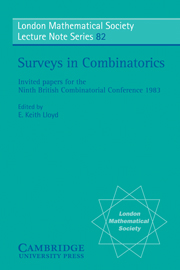Book contents
- Frontmatter
- Contents
- PREFACE
- GRAPHS AND INTERCONNECTION NETWORKS: DIAMETER AND VULNERABILITY
- THE FRIENDSHIP THEOREM AND THE LOVE PROBLEM
- MAXIMUM SETS IN FINITE PROJECTIVE SPACES
- QUASIGROUP IDENTITIES AND ORTHOGONAL ARRAYS
- BOUNDS ON PERMANENTS, AND THE NUMBER OF 1-FACTORS AND 1-FACTORIZATIONS OF BIPARTITE GRAPHS
- REDFIELD DISCOVERED AGAIN
- CHARACTERIZATIONS OF THE LIE INCIDENCE GEOMETRIES
- GL(n, C) FOR COMBINATORIALISTS
- IRREGULARITIES OF PARTITIONS: RAMSEY THEORY, UNIFORM DISTRIBUTION
- INDEX OF NAMES
- SUBJECT INDEX
CHARACTERIZATIONS OF THE LIE INCIDENCE GEOMETRIES
Published online by Cambridge University Press: 05 May 2013
- Frontmatter
- Contents
- PREFACE
- GRAPHS AND INTERCONNECTION NETWORKS: DIAMETER AND VULNERABILITY
- THE FRIENDSHIP THEOREM AND THE LOVE PROBLEM
- MAXIMUM SETS IN FINITE PROJECTIVE SPACES
- QUASIGROUP IDENTITIES AND ORTHOGONAL ARRAYS
- BOUNDS ON PERMANENTS, AND THE NUMBER OF 1-FACTORS AND 1-FACTORIZATIONS OF BIPARTITE GRAPHS
- REDFIELD DISCOVERED AGAIN
- CHARACTERIZATIONS OF THE LIE INCIDENCE GEOMETRIES
- GL(n, C) FOR COMBINATORIALISTS
- IRREGULARITIES OF PARTITIONS: RAMSEY THEORY, UNIFORM DISTRIBUTION
- INDEX OF NAMES
- SUBJECT INDEX
Summary
INTRODUCTION
A yery famous theorem (associated with the names Hilbert, von Staudt, Veblen and Young) characterizes projective spaces of dimension greater than 2 as linear incidence systems satisfying a certain (variously named) axiom. By the term “characterization”, one means a complete classification in terms of division rings. This famous characterization theorem fully displays the spirit of synthetic geometry in that one obtains an exact and elaborate structure with many subspaces from a few simple axioms mentioning only points and lines.
More than three decades later F. Buekenhout and the author obtained a characterization of polar spaces of rank more than 2 in terms of a similar set of very simple axioms concerning only points and lines. But this time the characterization rested on a considerably more involved theory of Veldkamp and Tits, where, in effect, the really difficult work was done. Indeed Tits' work on polar spaces (as axiomatized by him) was a part of his monumental classification of buildings of spherical type of rank greater than 2. The Buekenhout-Shult polar space theorem could then be seen as a characterization of the buildings of types C and D in terms of axioms involving only two types of varieties of the building. The question was then raised (see [20]) whether similar axiomatically simple “point-line” characterizations could be obtained for all the buildings of spherical type of rank at least 3.
- Type
- Chapter
- Information
- Surveys in CombinatoricsInvited Papers for the Ninth British Combinatorial Conference 1983, pp. 157 - 186Publisher: Cambridge University PressPrint publication year: 1983
- 5
- Cited by



